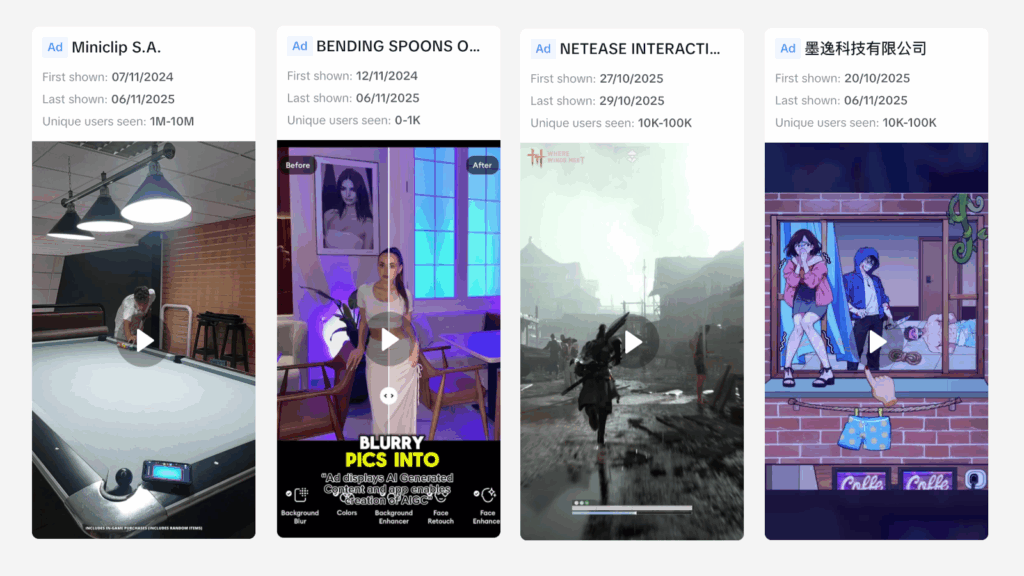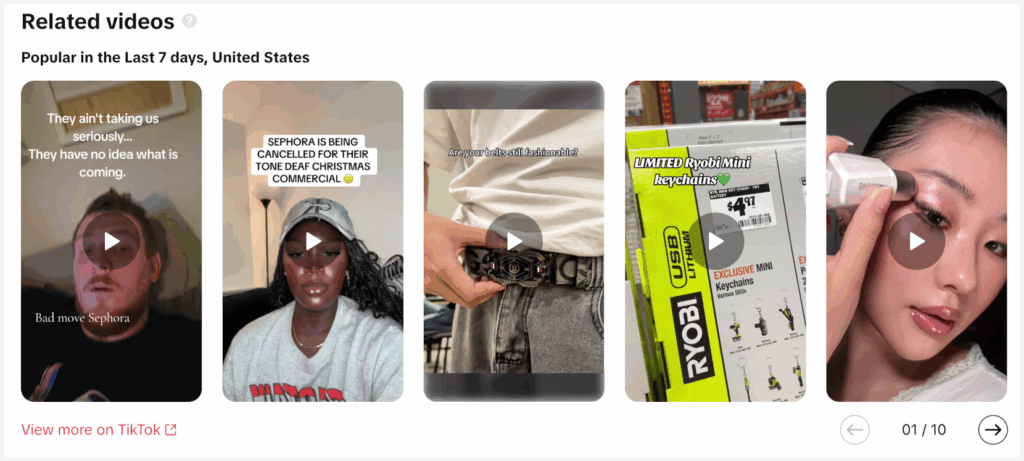Intro to App Marketing on TikTok: Hook, Entertain, Analyze & Optimize
 Gabriel Kuriata
Gabriel Kuriata  Gabriel Kuriata
Gabriel Kuriata TikTok is a global, video-first social discovery platform powered by a uniquely powerful recommendation algorithm that feeds users personalized, full-screen, sound-on, short-form video content on its “For You” Page (FYP).
TikTok is unique in how its algorithm prioritizes content affinity (what you watch and engage with) over social connections (who you know or follow). This means any app, regardless of its follower count, has the potential to go viral quickly.
For user acquisition of mobile apps and games, TikTok is fundamentally a discovery engine designed to introduce new projects to vast, receptive audiences at scale.
TikTok is the ideal platform for reaching a younger, highly engaged audience. A successful campaign should respect the style & tone of the platform, always staying on top of the latest trends.
This article aims to introduce you to the world of app marketing on TikTok, providing an overview of its philosophy, requirements, and opportunities, so you can determine whether this user acquisition channel is right for your business and app.
TikTok is an immersive and highly engaging ecosystem with over 1.5 billion monthly active users globally (as of early 2025), boasting an average daily usage time of approximately 95 minutes, which surpasses that of any other social network.
This makes TikTok an essential channel for mobile apps and games seeking to reach high-value users on a large scale: 82% of its users game at least once a week. The top 100 gaming-related hashtags have 30 billion monthly video views in the US alone. TikTok-driven app installs have high engagement and retention rates.
If you’re ready to tap into this ecosystem and promote your app or game, following its rules and unique approach to content, you can gain a critical user acquisition channel.
TikTok’s massive scale, combined with an algorithm that rewards authentic, trend-following content, allows mobile apps and games to cut through traditional advertising noise and reach millions of potential users who are actively in a discovery mindset.
Advertising success on TikTok is achieved by adhering to a specific philosophy that meets the user’s entertainment mindset.

The primary reason users open TikTok is for entertainment, not to shop or download apps. To be effective, ads must mimic organic content that appears to belong on the “For You” page.
Be Authentic, don’t be afraid to ditch the polished, high-budget cinematic commercials for smartphone footage. Embrace current hot trends, use fast cuts, trending sounds and music, and add simple on-screen text overlays. The goal is to make the user realize they’ve seen an ad only after you’ve delivered the hook and the app’s core value has been established.
TikTok is widely regarded as the best platform to reach a younger, highly engaged audience. While it does offer several demographic options, the most significant targeting factor is content affinity.
This means delivering the right creative content to people most likely interested in it, content that resembles what they’ve already engaged with. In practice, targeting should be grounded in understanding the audience’s interests and, most importantly, current trends for the increased likelihood of virality.
In this context, the creative itself is often your most powerful targeting tool. A high-performing, authentic video will naturally attract the right kind of user for your app, and the algorithm will follow. It’s the hook that will capture a user’s attention in the first few seconds.
For app marketers, this means success is heavily reliant on producing a high volume of user-generated content (UGC)-style creative (often via Spark Ads) that is constantly refreshed.
TikTok’s built an expansive advertising ecosystem, one to match its increasingly important role in the market, with dedicated solutions for e-commerce, entertainment, automotive, and mobile apps.
App marketing on TikTok can also employ multiple approaches, primarily determined by the desired scale and available budget, ranging from DIY content generation and user-generated content to full-fledged influencer marketing with top creators and expansive, impactful advertising campaigns.
Let’s briefly discuss TikTok’s framework for mobile app advertising, highlighting the key elements most relevant to newcomers and those looking to experiment with the platform for the first time.
TikTok’s Ads Manager allows for the display of ads across three placements:
Global App Bundle and Pangle can broaden reach and potentially lower the cost per thousand impressions (CPM). Still, for most app companies, the highest quality performance is usually achieved directly on TikTok.
TikTok offers multiple ad formats, enabling mobile apps to appear in the “For You” feed and beyond.
There are also premium variants available, such as Top View, which is displayed immediately after the app opens, allowing for a three-second takeover before introducing any interactive video elements. Top Feed is the first ad being shown after the initial organic videos.
Carousels are meant for e-commerce, showcasing multiple products that users can swipe through and convert on. There’s also a variety of interactive enhancements, generally defined by budget commitment, established relationship, and ad type.
The in-feed portrait video is the ‘king’ ad format on TikTok because it provides a user experience that is best aligned with the native content.
As hinted before, TikTok offers two approaches to advertising:

Let’s compare these two approaches:
| Non-Spark Ads | Spark Ads | |
| Creative source | You | Organic posts, created by you or an independent creator |
| Authenticity | Lower, as these are typically regular video advertisements. | Higher. The ad retains the creator’s profile, name, comments, and likes. |
Non-Spark Ads are excellent for quick and agile advertising when complete control over the narrative is necessary. They can be interactive (playable) or showcase products. Premium versions are also available, allowing the advertiser to capture more of the screen or even lock it for a short period of time. You don’t need an active profile on the platform or to maintain communication on TikTok to use this format.
Spark Ads are excellent at building trust by leveraging the creator’s genuine endorsement to convert skeptical users or by utilizing the app’s own content that has already resonated with the audience.
Both types of ads can be used effectively to capture attention and fit into the mindset and mood of the audience. Whether we choose a more straightforward approach with Non-Spark Ads or a more organic approach with Spark Ads depends on what we’re trying to promote. In theory, Spark Ads may have higher engagement but lower direct conversion to our monetized goal than Non-Spark Ads, but the creative itself plays a critical role in this process. On TikTok, where entertainment beats advertising, even flashy, interactive ads or premium formats may not be a game-changer.
For a platform that prioritizes content affinity, descriptively stating that “Subcultures are the new demographics”, understanding the psychological factors, needs, and current trends impacting them is critical. Consequently, research and competitive analysis are crucial for delivering engaging content and successful campaigns.
TikTok offers a wide range of tools to explore its marketing and competitive landscape, understand current trends, and diverse subcultures.
However, practice shows that successful presence is solidly grounded in data, and valuable information can be found in:
On TikTok, your success will be determined by your ability to spot trends early. TikTok calls them “Trend Moments” and although it offers great solutions to see what’s trending on the social media and find these trends on its Creative Center, relying on those usually means you’re already late, missing the biggest window for real growth.
From my experience, the fastest and most effective way is simply spending time on the platform — training your algorithm to show you the content you care about (by sharing, commenting, and liking). This way, whenever something starts trending in your niche, your feed will show it to you right away.
If you combine a powerful early-stage trend with other elements like Introductory Offers, you can achieve impressive improvements in the Conversion Rate — unlocking growth at a much faster pace than on other channels like Meta.
TikTok algorithm’s focus on content affinity means that strong trends are likely to emerge when users increasingly engage with materials covering similar themes, jokes, gags, or behaviors.
Many trends are built around participation, like dances, challenges, or specific comedic formats. Ads that tap into these formats naturally encourage higher engagement (likes, comments, shares) compared to static, non-trending content.

Trends are the language of TikTok. By adapting a trend to your brand’s message, you demonstrate that you understand the platform’s culture, making your brand feel relatable and less intrusive.
TikTok trends move incredibly fast, often lasting only a few days. To succeed, brands must be agile and quickly jump on a trend at its peak. This fast-moving culture rewards rapid content creation and iteration.
TikTok users have a strong preference for content that feels authentic, fun, and unpolished, unlike traditional, highly-produced ads. A successful TikTok ad must look and feel like organic, user-generated content (UGC).
Consequently, trends are the mechanism through which advertising seamlessly becomes entertaining content on TikTok, which is the key to maximizing reach and engagement on the platform.
TikTok offers a robust content creation and curation platform, making advertising as accessible as possible by significantly reducing the barrier of entry. This enables dynamic campaigns at scale for almost any app willing to offer its audience engaging content that is true to the platform’s principles and tone.
The tools above can provide you with insights, inspiration, and a framework needed to create and promote engaging content.
Effective performance extends beyond app installs, aiming to connect ads with users who are likely to make a purchase or subscription, thereby contributing to the campaign’s positive return on ad spend (ROAS). This means it’s critical to connect campaign data with post-installation metrics.
TikTok, like major platforms such as Meta (Facebook/Instagram) and Google, operates as a Self-Attributing Network (SAN), claiming credit for conversions based on its own ad interactions (clicks and views) within a set lookback window.
The native SDK is a suitable solution for small developers. Those striving for accuracy, comparative channel analysis, and to prevent overreporting conversions, Mobile Measurement Partner (MMP) integration is highly recommended.
TikTok offers robust configuration options. Several demographic options are available, but those related to interests should be considered critical, as the platform’s algorithm focuses on content affinity.
The platform encourages broad targeting and nudges advertisers towards its fully automated Smart+ campaign management (despite offering manual control as well), with both these options delivering sufficient data for the machine-learning algorithms to optimize campaigns more effectively.
Both models can be effective, and for newcomers, some testing and experimentation might be unavoidable.
TikTok provides multiple optimization and bidding strategies to support this goal, including:
As mentioned earlier, the platform’s demographic is young and highly engaged, with a strong gaming audience, making it possible to connect with high-LTV users and generate a significant return on ad spend (ROAS). In this context, having an MMP is critical for successful app promotion on the platform.
Creative optimization is a crucial aspect of overall campaign optimization on TikTok, with a key consideration being the creation or curation of content that resonates with our target audience.
Due to the platform’s high-velocity culture, an effective creative typically performs well for a maximum of 10–15 days. You must prioritize frequent asset rotation (ideally on a weekly basis) to counteract performance decay and fatigue.
To effectively advertise on the platform, you need to keep up with its trends, which might explode unexpectedly and last no longer than a week. Continuous monitoring and observation is a critical part of campaign optimization on TikTok.
TikTok employs an auction-based system to determine which ads are displayed, allowing advertisers to utilize various bidding strategies to optimize their results for specific goals.
Campaigns can be either manual or Smart+, which is fully automated using the platform’s machine learning algorithms to optimize performance.
Smart+ campaigns can be effective, provided our app or game is capable of gathering enough target events dynamically during the algorithm’s initial adaptive phase. Careful target goal selection for our campaigns can impact their ability to deliver conversions effectively.
Time to summarize our take on mobile app promotion and user acquisition on TikTok:
The key to TikTok success lies in creating high-volume, authentic, and trend-aware video content, as well as implementing innovative optimization strategies. Master these fundamentals first, and you’ll be ready to embrace even more features the platform offers, including its premium formats or influencer marketing. For even more effective user acquisition!
